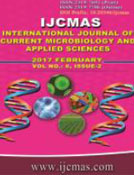


 National Academy of Agricultural Sciences (NAAS)
National Academy of Agricultural Sciences (NAAS)

|
PRINT ISSN : 2319-7692
Online ISSN : 2319-7706 Issues : 12 per year Publisher : Excellent Publishers Email : editorijcmas@gmail.com / submit@ijcmas.com Editor-in-chief: Dr.M.Prakash Index Copernicus ICV 2018: 95.39 NAAS RATING 2020: 5.38 |
A field experiment was conducted in a farmer’s holding at Sethumadai, Pollachi, Tamil Nadu to develop integrated pest management strategy against sucking pest complex of cocoa including tea mosquito bugs, mealybugs and aphids during 2014-2015 using randomised block design with three treatments (IPM module, farmer’s practice and control) and replicated seven times in an area of 10,000 m2. The experimental results revealed that the IPM strategy was significantly superior to farmer’s practice and untreated control in reducing the population of aphids (Toxoptera aurantii), mealybugs (Paracoccus marginatus and Planococcus citri) and tea mosquito bugs (Helopeltis bradyi and H. antonii) with the mean per cent reduction of 91.1, 94.0 and 84.4 over control, respectively. Number of Cryptolaemus montrouzieri, Spalgis epeus, syrphids and spiders recorded at 21 days after treatment were 5.7, 4.1, 2.1 and 1.7 per tree in IPM strategy as against 1.2, 0.5, 0 and 0.8 per tree in farmer’s practice, respectively. Regarding yield parameters, the maximum number of harvestable pods (28.6), maximum pod length (18.5 cm), maximum pod girth (26.6 cm), maximum pod weight (588.8 g), highest number of beans (37.9), highest wet bean weight per pod (126.0 g), maximum dry bean weight per pod (39.4 g) and the highest dry bean yield of 984 g per tree per season were recorded in IPM plot than the farmer’s and untreated control. Based on the results, the IPM strategy was adjudged as the most effective treatment for the protection of cocoa against attack by sucking pests. It is concluded from the results that adoption of the IPM strategy is recommended not only to increase the productivity of cocoa, but also to conserve the natural enemies and pollinators in the cocoa ecosystem.
 |
 |
 |
 |
 |